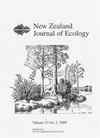Influence of weather on long-tailed bat detection in a North Island exotic forest
IF 1.4
3区 环境科学与生态学
Q3 ECOLOGY
引用次数: 0
Abstract
: Accurate surveys and monitoring are required to guide the conservation and management of threatened species. Some fauna species are cryptic or difficult to observe because they are nocturnal, mimic other species, conceal themselves, or can be incredibly hard to survey. Emergence and activity of these species may be related to complex environmental cues including weather and atmospheric conditions. The conservation status of New Zealand’s long-tailed bat ( Chalinolobus tuberculatus ) is Threatened-Nationally Critical. Occurrence and activity of long-tailed bats is commonly monitored with acoustic bat detectors. However, even in locations where long-tailed bats are known to be present, they may only be detected on a subset of nights meaning that detection with acoustic detectors is imperfect. We analysed long-tailed bat detection data collected in Kinleith Forest, central North Island, New Zealand in 2006 and 2007 using zero-inflated generalised linear (mixed) effect models. We found relationships between bat detection and several environmental variables. Results suggest that bat surveys would be most effective at detecting bats when undertaken one to four hours after sunset, on nights when the temperature at sunset is above 8°C, and preferably when the temperature stays in the 8 and 17°C range during the night. Higher humidity and a light breeze may also be a desirable condition for monitoring. A night that is similar to, or slightly warmer, than recent nights may be favourable. Caution should be taken extrapolating these results to elsewhere because bats in other regions may respond differently to temperatures out of necessity. High site-specific variation in bat counts at higher temperatures and humidity occurred with zero activity often recorded. Therefore, we caution against assuming bats are absent because they have not been detected by surveys undertaken during higher temperatures and humidity conditions unless surveys have been run for multiple nights in suitable conditions.气候对北岛外来森林长尾蝙蝠探测的影响
本文章由计算机程序翻译,如有差异,请以英文原文为准。
求助全文
约1分钟内获得全文
求助全文
来源期刊

New Zealand Journal of Ecology
环境科学-生态学
CiteScore
3.00
自引率
12.50%
发文量
35
审稿时长
>36 weeks
期刊介绍:
The New Zealand Journal of Ecology is a biannual peer-reviewed journal publishing ecological research relevant to New Zealand/Aotearoa and the South Pacific. It has been published since 1952 (as a 1952 issue of New Zealand Science Review and as the Proceedings of the New Zealand Ecological Society until 1977). The Journal is published by the New Zealand Ecological Society (Inc.), and is covered by Current Contents/Agriculture, Biology and Environmental Science, GEOBASE, and Geo Abstracts.
 求助内容:
求助内容: 应助结果提醒方式:
应助结果提醒方式:


